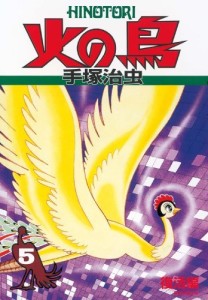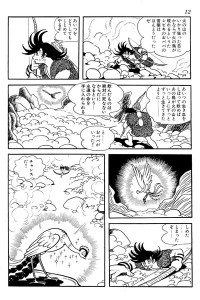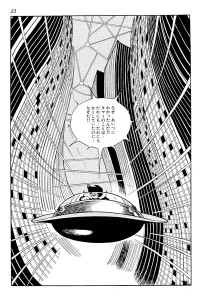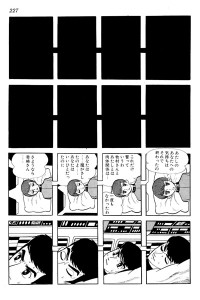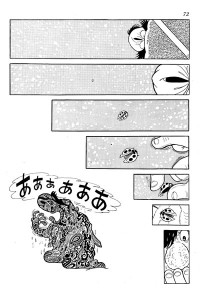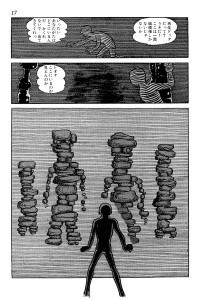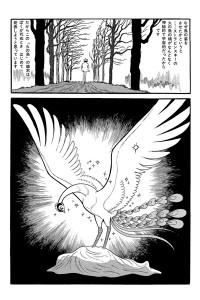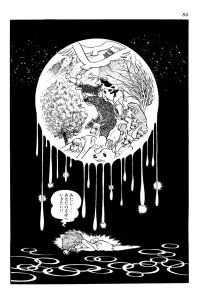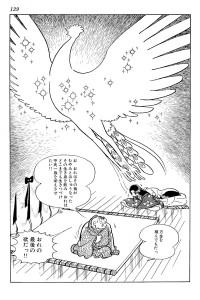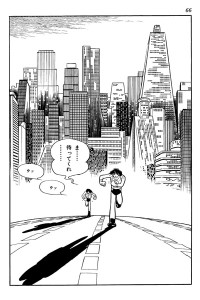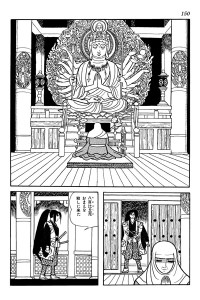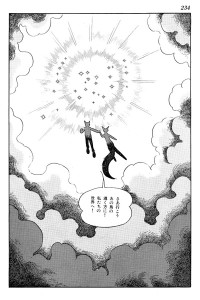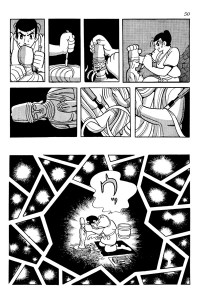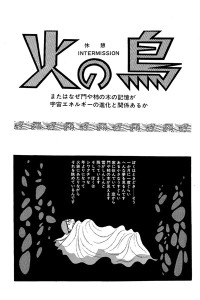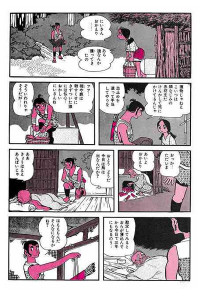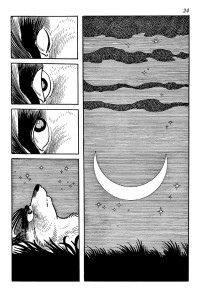Phoenix (Manga)
Also known as 火の鳥 (Hi no Tori)
| English Title: | Phoenix |
| In English? | Yes |
| Japanese Title: | 火の鳥 Hi no Tori |
| Type: | Ongoing Serial |
| Original run: | 1967 – 1988 |
| Published in: | COM |
| Published by: | Mushi Productions |
| Volumes: | 13 MT-201 | MT-202 | MT-203 MT-204 | MT-205 | MT-206 MT-207 | MT-208 | MT-209 MT-210 | MT-211 | MT-212 MT-362 | MT-363 | MT-364 MT-365 |
There are several very different versions of Tezuka’s Phoenix series. The earliest incarnation of the story was first published from 1954-55 in Manga Shonen. When that publication suddenly folded, a reworked manga version aimed at young girls was published between 1956-57 in Shojo Club. However, by far, the most well-known is Phoenix (1967-88), the series of twelve loosely connected stories – with the first chapter, “Dawn” published in COM magazine in 1967, and the last, “Sun”, appearing in 1988 in The Wild Age.
What it’s about
Phoenix (1967-88), sometimes also referred to as the COM edition, features stories that consist of everything from romantic love stories to sci-fi adventure, to historical drama. Although only loosely connected, each of the stories is linked by the presence of the mythical bird known as the Phoenix, an immortal guardian of the universal life force. The twelve “core” stories are all self-contained and, when read in the order they were published, jump across time with the settings alternating between the distant past and the far-flung future – with each working the story ever closer towards a middle point in “the present”.
Phoenix: Chapter of ‘Dawn’ (1967) –Set in the period between 240 – 270 A.D. The story opens with Nagi, a young boy who lives in a village at the foot of a volcano, on the hunt for the mythical Phoenix – a magical bird whose blood grants eternal life. Meanwhile, Dr. Guzuri washes ashore and, with his medical knowledge and skill, quickly wins the trust of the entire village. Although Dr. Guzuri ends up marrying Nagi’s older sister, Hinaku, it is soon revealed he is a spy sent by Queen Himiko to serve as an advance to an invasion by the neighbouring kingdom of Yamatai.
That night, the Yamatai army, under the command of General Sarutahiko attacks the village an wipes it out completely. In the aftermath, Sarutahiko enslaves Nagi and vows to make him a hunter of repute by capturing the Phoenix. However, with immortality on the line, the situation quickly turns into a complex and multi-faceted struggle for the blood of the Phoenix.
Phoenix: Chapter of ‘Future’ (1967-68) – In the far-flung and ultra-futuristic world of 3404 A.D., the Earth is showing signs of decay. Human beings, in their underground city-states, are in a state of decline. Against this backdrop, Masato Yamanobe, a second-class space soldier, falls in love with his girlfriend, Tamami – who is in reality an alien shape-shifter known as a Moopie. Hiding their illicit and illegal love affair from the authorities, the pair soon run afoul of Rock, Masato’s megalomaniac supervisor.
The pair quickly escape to the desolate “no-man’s land” outside the city, and, guided by the mythical Phoenix, make their way to Dr. Saruta’s base. Within the safety of the dome, Masato and Tamami learn about Dr. Saruta’s research on artificial life, with the goal of returning extinct life forms to the Earth.
However, Rock is determined to start a nuclear war against a neighbouring city-state, and the ensuing conflict results in the extinction of the human race.
Phoenix: Chapter of ‘Yamato’ (1968-69) – Based on the legend of Yamato Takeru, between 320 – 350 A.D., in a period also known as the Kofun, the decadent King of Yamato sends his son, Prince Oguna, out from Kyushu to conquer a neighbouring “barbarian” tribe, the Kumaso. The king’s motive is to eradicate a rival (and unbiased) account of history so that he can have it rewritten more to his liking.
Prince Oguna though, has an alterior motive – to locate the lifeblood of the Phoenix in an attempt to save the innocent people set to be immolated upon his father’s death.
However, Prince Oguna quickly comes to respect Takeru, the Kumaso King, and begins to fall in love with his younger sister, Kajika. Strangely though, the Phoenix appears before Oguna and tells him to return to Yamato. Even though it means killing Takeru, he does, and returns with a cloth soaked with the Phoenix‘s blood.
Although he is unsuccessful in stopping the construction of the king’s tomb and ends up being buried alive with the rest of the sacrifices, he is able to share the blood of the Phoenix with them. And so, despite being buried alive, they continue to sing out their defiance.
Phoenix: Chapter of ‘Universe’ (1969) – In 2577 A.D., a spaceship from Earth enroute to Zaltz, the third planet in the Betelgeuse system, is stranded after a mishap with cosmic dust. When the four astronauts awake from their hibernation, they discover the mummified corps of Makimura – the crew member assigned to watch over the sleep pods. Forced to escape their ruined ship, they take refuge in individual life pods and attempt to make their way to a nearby planet.
While the four travel along, they suddenly notice that a fifth escape pod is following them… a pod that can only be the deceased Makimura’s. Soon two of the pod’s fall behind, and Saruta, Nana and Makimura’s escape pods are guided to a mysterious planet by the Phoenix, where they crash-land and are separated.
Nana discovers that Makimura is indeed back among the land of the living, reborn as a baby, and she vows to take care of him. However Saruta soon cross paths with the mysterious Phoenix, and disguised a bird-woman from another planet, she tells him that Makimura is a space criminal doomed to endlessly endure the cycle of birth and death…
Phoenix: Chapter of ‘Hō-ō’ (aka ‘Karma’) (1969-70) – In 720 – 752 A.D., during the Nara period, a one-eyed, one-armed young man named Gao (who just happens to be an ancestor of Saruta) is cast out of his village and, out of spite, turns into a murderous bandit. However, when his life is saved by the high priest Shonin Robem, Gao begins to change. As the two men begin to travel together, Gao begins to see many people suffering from disease and death- an experience that unleashes his hidden artistic talents as a sculptor.
Meanwhile, Akanemaru, a man who had been attacked by Gao in his younger days, recovers from his injuries and becomes a famous Buddhist sculptor – something that links the two men’s destinies. Akanemaru, eventually becomes the driving force behind the construction of the great Buddha statue at Todaiji Temple in Nara. When Tachibana Moroe, a man of great power and Akanemaru’s benefactor, decides to let Akanemaru and Gao compete over the right to produce the capping tile for the roof of the great Buddhist temple, the two men meet again, this time as rivals.
One the one hand, Akanemaru becomes obsessed with the Phoenix and ends up losing sight of his original purpose – to the point that he discloses Gao‘s past to avoid defeat. On the other hand though, Gao eventually comes to know a sense of peace and tranquility despite the hardships he faces, including having his remaining right arm cut off.
Phoenix: Chapter of ‘Resurrection’ (1970-71) – In the period between 2482 – 3344 A.D., in an age full of the wonders of science and technology, a young man name Leon “dies” in a mysterious car accident. Although he is returned to life by Dr. Nielsen, using the miracle of advanced medical technology, a strange by-product of his now partially cyborg brain causes him to see living things (including human beings) as distorted clay figures, while he sees machines and robots as things of beauty.
Leon soon falls in love with a clerical worker robot, known as Chihiro, who despite being an expressionless, cold being made of metal, he sees as a beautiful young girl. Strangely enough, even though robots have no emotions, Chihiro also starts to develop strong feelings for Leon as well. However, given that human/robot romances are forbidden, the two young lovers have to flee to stay together.
This leads Leon on a quest to find out how, in an age of advanced science, he could be the victim of a car accident, which, in turn, eventually brings him into contact with a group of smugglers dealing in space immigrants. In the end, Doc Weekday, a physician involved with the smugglers, in response to Leon’s last words, creates a robot by combining Leona’s and Chihiro’s minds – a robot known as Robita.
Phoenix: Chapter of ‘Robe of Feathers’ (1971) – Based on the story of the Hagoromo. In the period between 937 – 941 A.D., Zuku, the hunter, finds a beautiful robe draped over a bench next to a pine tree he tries to sell it. However, he hears a woman’s voice who tells him the robe is hers and she wants it returned. Zuku asks who she is, and she tells him her name is Otoki, and that she has traveled there from a country from far beyond the sky.
Although Zuku thinks Otoki is an angel, in fact, she is a time-traveler from the far future. Otoki fears that if her robe from the future were to be sold, it would change the course of history. As such, Otoki stays with Zuku, and the couple soon have a baby together.
However, one day some samurai come from the capital and try to conscript Zuku. And so, despite her fears, Otoki hands over the robe to the samurai to save him.
Phoenix: Chapter of ‘Intermission’ (1971) – This short interlude explains some of Tezuka’s views on cosmic energy and why the Phoenix is the incarnation of the universe’s mysterious life force.
Phoenix: Chapter of ‘Nostalgia’ (1976-78) – Some time in the 25th Century, shortly after space explorers George and Romi arrive and begin to set up a new life for themselves on the deceptively named desert planet Eden 71, George dies in an accident. However, despite being now alone, Romi, who was pregnant at the time, gives birth to George’s son. Realizing that the colonization of the planet rests on her shoulders, she repeatedly tries to procreate with her own offspring. Using a form of suspended animation, generation after generation, she awakes for each successive attempt, but it is no use, her offspring are only ever boys.
Finally, however, the Phoenix intervenes and allows the shapeshifting aliens, the Moopies to have children with Romi’s descendants. With the cycle of futility broken, Romi does not have to return to the state of suspended animation and instead becomes the Queen of Eden. However, she begins to long to return to Earth.
Then, one day, a young boy named Com happens upon a mysterious spaceship made out of rock, hidden deep in prohibited area of the mountains. And so, yearning to see the planet of his ancestors, Com joins Romi on a voyage to a planet he has never seen before… Earth.
Phoenix: Chapter of ‘Turbulent Times’ (aka ‘Civil War’) (1978-80) – Towards the end of the Heian Period, between 1172 – 1189 A.D., a woodcutter named Benta comes to the capital of Kyoto in search of his childhood sweetheart, Obu who has been kidnapped. During his travels, Benta meets a Gao, a 400-year-old hermit, and a boy named Ushiwaka – eventually becoming Ushiwaka’s retainer. Meanwhile, Obu is pressed into service as the attendant of a power man, Kiyomori Taira who is obsessed with extending his life through the blood of the Phoenix.
However, Kiyomori fails in his quest and dies, just as the capital is driven into chaos and civil war, throwing the world into confusion and chaos.
Ushiwaka, now grown, is renamed Yoshitsune and becomes the head of the Genji family. With the Genji and Heije families in opposition, Benta begins to feel the strain of being in Yoshitsune’s service, given Yoshitsune’s complete disregard for his soldiers’ lives. Against the backdrop of the Dannoura War, Benta finally crosses paths with Obu once again…
Phoenix: Chapter of ‘Life’ (1980) – 2155 – 2170 A.D., TV producer who attempts to procure human clones to use in a The Most Dangerous Game-style reality TV program learns the error of his ways when he is mistaken for a clone himself. This episode is notable for only featuring the Phoenix in flashbacks and also for introducing her half-human daughter who does not appear again after this episode.
Between 2155 – 2170 A.D., Aoi, a TV producer struggling in the ratings and desperate to find the “next big thing”, comes up with the idea of having a television show based on the idea of hunting down and killing human clones. In an attempt to procure some clones for his show, he travels a research centre in the Andes mountains. Along with Saruta, a researcher at the centre, Aoi meets the half-human descendant of the Phoenix, and an Incan deity, who holds the secret of cloning. When Aoi, himself, is cloned, the TV station begins broadcasting the new show – with Aoi ending up as the target of pursuit. While trying to evade his hunter, Aoi comes into contact with a girl named June and through her, rediscovers his own sense of humanity. Realizing the error of his ways, Aoi decides to mount an attack on the clone factory itself – blowing up the facility were human clones are produced only to be killed for sport.
Phoenix: Chapter of ‘Strange Beings’ (1981) – Between 1468 – 1498 A.D., Sakonosuke, the daughter of the brutal Lord Iemasa Yagi who has been brought up as a male, leaves on a mission with “his” retainer, Kappei, to kill the nun Yaobikuni, of Horai Temple. Sakonosuke is attempting to kill the nun because, despite being able to cure any disease, she refused to treat his father’s fatal illness. However, Sakonosuke, who has been forced to live as a man, naturally harbours a great hatred for his father – believing he will never be able to go back to living as a woman until such time as his father dies.
Sakonosuke kills Yaobikuni, but on his way back home, a mysterious force sends him back to Horai Temple, and he finds he is unable to leave. When some villagers arrive at the temple and request their various diseases be cured, Sakonosuke disguises himself as Yaobikuni and cures them using the “glimmering feather” of the temple. It soon becomes apparent that the temple is located in a time-warp and that Yaobikuni is, in fact, the future incarnation of Sakonosuke. Yaobikuni, imprisoned by the Phoenix as punishment for her sins, becomes a healer, treating the victims of wars from all over time and space – including humans as well as a host of extraterrestrials.
Phoenix: Chapter of ‘Sun’ (1986-88) – In 663 – 672 A.D., the allied Wakoku (Japan)/Baekje (Korea) Army is locked in battle against the Tong (China)/Shilla (Korea) Army during the Hakusukinoe War – site of the modern-day Kinko River in Korea. After the Wakoku/Baekje army suffers a crushing defeat, Harima, a young Baekje soldier, is captured by Tong soldiers and has his face skinned and replaced with that of a wolf.
Harima, now with the face of a wolf is saved by a mysterious old woman and, taking her advice, he travels to Wakoku. There he meets a group of indigenous gods, known as the “Ku”. Although humans had once deified the “Ku”, it was viewed as a form of “devil worship” after Buddhism was introduced to Japan. And so, after learning how the “Ku” were banished away from human habitation, deep into the mountains, Harima swears to help them.
However, Harima, who had been tortured by nightmares ever since his face was replaced with that of a wolf, gradually begins to sense his “future self”. He is then transported to the 21st Century and discovers he is Suguru Bandow, one of the undesirable “Shadows” – people that have been banished by a religious sect known as “Hikari” (aka “The Light”). Using the moral authority of the Phoenix, who they worship as a deity, “The Light” have been able to place all of Japan in its thrall. However, Suguru, and the other “Shadows” are locked in battle against “The Light” – a struggle that strongly echoing that between the Buddhist establishment and the indigenous gods.
What you should know
Phoenix is considered Tezuka’s life’s work for good reason. The core ideas and concepts of Phoenix – life, death and the cycle of rebirth – were continuously re-explored by Tezuka, almost from the very beginning of his career right up to his death in 1989.
When it came time to follow up on the successful serialization of Jungle Emperor (1950-54) in Manga Shonen, Tezuka decided that the story of the mythical bird that dies in its own flames and is then reborn would have some synergy with his tale of the white lion. So, drawing inspiration from Igor Stravinsky’s ballet, L’oiseau de Feu, not to mention a healthy dose of the visual design from Ivanov-Vano’s Soviet animated feature film, The Humpbacked Horse (1947), Osamu Tezuka’s Phoenix [Manga Shonen] (1954-55) began publication in July 1954.
Unfortunately, Phoenix [Manga Shonen] (1954-55) was discontinued in May 1955 after just eight installments when Manga Shonen‘s publishing company suddenly went bankrupt. So, with the story incomplete, Tezuka abandoned the project – but not the concept. Exactly one year later, in May, 1956, as a follow-up project to Princess Knight [Shojo Club] (1953-56), Tezuka reworked the story into a romantic epic for young girls. And so, Phoenix [Shojo Club] (1956-57) began to be serialized in Shojo Club in May 1956, with the story coming to its natural conclusion in December 1957.
Yet the ideas of resurrection, eternal life, and how people could be caught up in a struggle over the blood of the Phoenix in order to gain them, continued to intrigue Tezuka. Since the original story-line had never been completed, and had then been followed by a totally new and unrelated plot in the Shojo Club edition, in 1967 Tezuka returned to the series for a third time – this time with stories geared towards a more mature audience.
The Phoenix chapter ‘Dawn’ began to be serialized in the inaugural issue of COM – a new, and cutting edge, manga magazine showcasing avant-garde and experimental works. Serialized in COM from January to November, 1967, this version of ‘Dawn’ is essentially a re-working of the original story from Phoenix [Manga Shonen] (1954-55), and acts more or less as the prologue to the grand epic, Phoenix (1967-88) – a series that is focused on the theme of life and death of humans.
In all, seven complete chapters of Phoenix (1967-88): ‘Dawn’, ‘Future’, ‘Yamato’, ‘Universe’, ‘Hō-ō’ (also known as ‘Karma’), ‘Resurrection’, and ‘Robe of Feathers’ were serialized in COM between 1967-71.
In November 1971, Tezuka published a short (just 6 pages) Phoenix chapter, known as ‘Intermission’, before embarking on the eighth chapter. However, shortly after ‘Nostalgia’ began – appearing just twice in the December 1971 and January 1972 editions – COM underwent a drastic change in its editorial policy and was re-launched as COM Comics, effectively suspending the publication of Phoenix. However, after the re-brand proved unsuccessful, in a last gasp attempt to revive the original COM, it did appear one more time in August 1973 – featuring the start to an early version of ‘Troubled Times’. However, this ultimately proved to be a one-off issue and COM disappeared again, this time for good… leaving the early version of ‘Troubled Times’ unfinished almost before it started.
But you can’t keep a good thing down for long, and in September 1976 Phoenix (1967-88) made a reappearance in the inaugural issue of Manga Shonen, a new monthly magazine published by Asahi Sonorama – of no relation, despite the title, to the original Manga Shonen where Phoenix [Manga Shonen] (1954-55) got it’s aborted start over twenty years earlier.
Instead of continuing the story of ‘Troubled Times’ from where it had left off three years earlier, Tezuka decided to return to the (also aborted) chapter of ‘Nostalgia’. Yet this contained a bit of a conundrum for Tezuka, as he couldn’t simply continue from where he’d left off. The primary reason for this was that the four-and-a-half year gap meant it would be necessary to reprint ‘Nostalgia’ from the beginning to bring readers up to speed – which would have to include the original “prologue” chapter, ‘Robe of Feathers’ as well. However, that chapter had featured atomic bomb survivors as its protagonists, including somewhat graphic depictions of radiation sickness – a particularly touchy subject in Japan. So, despite clearly emphasizing Tezuka’s life-long anti-war message, the story had received much criticism after its initial publication in COM – mostly claiming a lack of sensitivity towards the real-life survivors of atomic blasts. As such, always concerned with feedback from his readership, Tezuka declined to reprint it. Instead, in typical fashion, Tezuka simply started over from scratch and published a completely knew, and unrelated version of ‘Nostalgia’. As for ‘Robe of Feathers’, it was eventually reprinted in 1980, albeit with heavily edited dialogue, before it too was completely reworked for its inclusion in the Osamu Tezuka Complete Works edition (MT-208) in 1983 – the version which was included in VIZ’s English-language release.
Following ‘Nostalgia’, a rebooted ‘Turbulent Times’ (also known as ‘Civil War’), ‘Life’, and ‘Strange Beings’ were all serialized in Manga Shonen between 1976-81. Yet Tezuka continued to explore the themes of Phoenix throughout his career, with the last chapter to see print, ‘Sun’ serialized in Wild Times from 1986-88. Although Tezuka had plans to continue the series (indeed a rough plot summary of the next story to be set during the Sino-Japanese war does exist), the series was tragically cut short by Tezuka’s death in February, 1989.
Despite being an incomplete masterpiece, each chapter features an independent story and can be enjoyed on its own. Beginning with the ancient past and then the the far-flung future, each chapter moved the over-arching story back and forth, from both ends of history, closer and closer towards a meeting in “the present”. By incorporating a more limited and focused version of his Star System, Tezuka is able to explore his central theme of reincarnation, by having his characters play similar roles, sometimes under very different conditions or situations. A prime example of this is Saruta, by exploring the growth and development of his character from the ancient past to the far-flung future, Tezuka is able to illustrate his interpretation of the theme of eternal life. Of course, had it been completed, Tezuka Osamu’s vision of the concept of reincarnation would have been fully revealed.
Many of the Phoenix (1967-88) stories feature intensely experimental layout and visual design. For example, ‘Universe’ tells the story of four spacefarers who are forced to leave their spaceship in separate escape pods. The panels of the story are organized such that each character has his own vertical or horizontal tier on the page, emphasizing the astronauts’ isolation; the tiers combine and separate as characters join together and split up. In another example, in an astonishing sequence after one character’s death, he is represented for a number of pages by a series of empty black panels.
Where you can get it
Luckily for English-speaking fans, VIZ published nearly all of Phoenix (1967-88) in a 12-volume collection between 2003-2007. Although the series is complete in terms of the core stories, unfortunately it does not contain the early, unfinished versions of ‘Dawn’, ‘Nostalgia’ and ‘Turbulent Times’, the original version of ‘Robe of Feathers’, nor the short chapter ‘Intermission’.

